 Last additions - KYOTO 京都府 Last additions - KYOTO 京都府 |

Jan 30, 2010
|
|

GravestoneJan 30, 2010
|
|

Jan 30, 2010
|
|

Jan 30, 2010
|
|

Jan 30, 2010
|
|

Jan 30, 2010
|
|

Some toriis are old and broke off.Jan 30, 2010
|
|

Jan 30, 2010
|
|

You can also draw your own fox face.Jan 30, 2010
|
|

Jan 30, 2010
|
|

Jan 30, 2010
|
|

Continuing up the torii hiking trail. It takes about 90 min. to walk the entire looping trail. You can turn back anytime if it's too hard for you. But it's not a difficult hike.Jan 30, 2010
|
|

Votive tablets in the shape of a fox. Write your wishes on it.Jan 30, 2010
|
|

Jan 30, 2010
|
|

Jan 30, 2010
|
|

Jan 30, 2010
|
|

Every once in a while along the path of toriis, there is a shrine which you can pray to.Jan 30, 2010
|
|

Inside the tunnel of toriis at Fushimi Inari Shrine in Kyoto, all donated to the shrine by companies.Jan 30, 2010
|
|

Go left.Jan 30, 2010
|
|

Entrance to the hiking trail of torii gates.Jan 30, 2010
|
|

Entrance to the hiking trail of torii gates, what Fushimi Inari Shrine is famous for.Jan 30, 2010
|
|

Map of the shrine complex, with a hiking trail up the mountain lined with the famous torii gates. Jan 30, 2010
|
|

More lesser shrinesJan 30, 2010
|
|

Jan 30, 2010
|
|

Tying the omikuji fortune papers.Jan 30, 2010
|
|

Fortune papersJan 30, 2010
|
|

Jan 30, 2010
|
|

Jan 30, 2010
|
|

Another shrine.Jan 30, 2010
|
|

2010 is the Year of the Tiger.Jan 30, 2010
|
|

Lucky charms for sale. Make no doubt, religion is big business in Japan. They are in the business of selling hopes and dreams with no money-back guarantee of success nor satisfaction. Only a religion can get away with selling something which may not work.Jan 30, 2010
|
|

Jan 30, 2010
|
|

People lining up to enter inside the shrine hall for more personalized prayers.Jan 30, 2010
|
|

The fox is the god's messenger at the Inari Shrine.Jan 30, 2010
|
|

Finally, we got in and could pull these ropes to ring the bell to get the attention of the god of wealth.Jan 30, 2010
|
|

All you hear are these bells ringing overhead.Jan 30, 2010
|
|

The crowd behind me.Jan 30, 2010
|
|

The crowd behind me.Jan 30, 2010
|
|

The main shrine hall is the target of all these people.Jan 30, 2010
|
|

Jan 30, 2010
|
|

Fushimi Inari Taisha, Kyoto. Inch by inch, we crept toward the main shrine on New Year's Day.Jan 30, 2010
|
|

This is where you can apply (and pay) to enter the shrine hall for prayers.Jan 30, 2010
|
|

Jan 30, 2010
|
|

How it looks from the top of the steps. Hordes of people coming to the shrine to pray for prosperity in the new year.Jan 30, 2010
|
|

Jan 30, 2010
|
|

Jan 30, 2010
|
|

Jan 30, 2010
|
|

Jan 30, 2010
|
|

Jan 30, 2010
|
|

Jan 30, 2010
|
|

Loads of people heading for the shrine, but we progressed quickly enough.Jan 30, 2010
|
|

I visited Fushimi Inari Taisha Shrine on Jan. 1, 2010. At the Kyoto City Tourist Info office, I asked which shrine was Kyoto's most popular on New Year's Day. They told me it was this shrine, so I came here.Jan 30, 2010
|
|

Fushimi Inari Taisha Shrine is near this JR Inari Station on the Nara Line, a 5-min. train ride from Kyoto Station. Also near Fushimi-Inari Station on Keihan Line.Jan 30, 2010
|
|
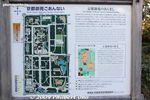
Map and about the Kyoto Gyoen National Garden.Jan 23, 2010
|
|

Model of Kyoto Imperial Palace.Jan 23, 2010
|
|

Sweets sold for the 20th anniversary of the enthronement.Jan 23, 2010
|
|

Scale model of the Kyoto Gyoen National Garden.Jan 23, 2010
|
|

Jan 23, 2010
|
|

Seishomon Gate was the exit. This is the gate normally used by the public. In the old days, it was the palace's "kitchen door" since it was used as a service entrance. It was also used by Imperial children. 清所門Jan 23, 2010
|
|

Juni-hitoe kimono worn by the empress.Jan 23, 2010
|
|
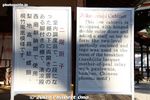
About the Nikai-zushi cabinet.Jan 23, 2010
|
|

Displayed behind the wedding attire was this Nikai-zushi cabinet.Jan 23, 2010
|
|
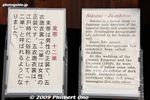
About the juni-hitoe kimono and sokutai. Jan 23, 2010
|
|

Wedding attire of the empress wearing juni-hitoe kimono, and the emperor wearing sokutai. Jan 23, 2010
|
|

Roof of Kogogu Tsunegoten.Jan 23, 2010
|
|

Behind the Kogogu Tsunegoten was a display of wedding attire of the emperor and empress.Jan 23, 2010
|
|
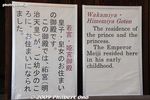
About the Wakamiya/Himemiya Goten.Jan 23, 2010
|
|

Wakamiya/Himemiya Goten. Normal kids would rip up the paper sliding doors.Jan 23, 2010
|
|

Wakamiya/Himemiya Goten Jan 23, 2010
|
|

Connected to the Higyosha is the Wakamiya/Himemiya Goten palace where Imperial children lived. Emperor Meiji lived here during childhood. Jan 23, 2010
|
|

Rooms inside the Wakamiya/Himemiya Goten. The building had two sections of four rooms each. One section was for child princes (wakamiya) and the other was for child princesses (Himemiya).Jan 23, 2010
|
|

HigyoshaJan 23, 2010
|
|

About the Higyosha.Jan 23, 2010
|
|

Higyosha (also called Fuji-tsubo because of the wisteria in the inner courtyard) was the residence of the court ladies. It has a Heian-kyo style architecture. 飛香舎 藤壺Jan 23, 2010
|
|

Sakuheimon Gate 朔平門Jan 23, 2010
|
|

Sakuheimon Gate, the main gate to Kogo Otsunegoten. Ornate but it was too narrow for us to get a good front view. 朔平門Jan 23, 2010
|
|

Genkimon Gate 玄輝門Jan 23, 2010
|
|

Jan 23, 2010
|
|

Painted fusuma sliding doors in the Kogogu Tsunegoten.Jan 23, 2010
|
|

The Kogogu Tsunegoten has 13 rooms. The building was constructed at the end of the 16th century.Jan 23, 2010
|
|

The northern palace quarters is dominated by this Kogogu Tsunegoten, the former residence of the empress. So, did the emperor and empress live separately? 皇后宮常御殿Jan 23, 2010
|
|

Going through another gate to the northern quarters.Jan 23, 2010
|
|

A nice wooded path to the northern palace quarters of Kyoto Imperial Palace.Jan 23, 2010
|
|

Entering the northern palace quarters.Jan 23, 2010
|
|

The normal palace tour would end here, but for Emperor Akihito's 20th anniversary, we were allowed to proceed to the northern palace quarters. 清所門Jan 23, 2010
|
|

Jan 23, 2010
|
|

Jan 23, 2010
|
|

Jan 23, 2010
|
|

Jan 23, 2010
|
|

Jan 23, 2010
|
|

OtsunegotenJan 23, 2010
|
|

Jan 23, 2010
|
|

Otsunegoten. The connected building beyond is the Omima.Jan 23, 2010
|
|
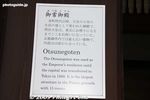
About the Otsunegoten in English.Jan 23, 2010
|
|

Jan 23, 2010
|
|

About the paintings in a room of the Otsunegoten.Jan 23, 2010
|
|

The Otsunegoten has 15 rooms. 常御殿Jan 23, 2010
|
|

Rooms of the Otsunegoten had painted walls and sliding doors. 御常御殿Jan 23, 2010
|
|

Jan 23, 2010
|
|

Now we came to the palace's largest structure called Otsunegoten. This was the actual residence of the emperor. Emperor Meiji lived here until he moved to Tokyo.Jan 23, 2010
|
|

Gonaitei Garden was the emperor's private garden. 御内庭Jan 23, 2010
|
|

Painting inside the Ogakumonjo.Jan 23, 2010
|
|

Jan 23, 2010
|
|

Jan 23, 2010
|
|

Palace guardJan 23, 2010
|
|
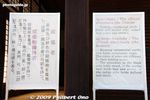
About the palace guards and official attendants.Jan 23, 2010
|
|

The Ogakumonjo had a display of palace guards and official attendants.Jan 23, 2010
|
|

The Ogakumonjo was the emperor's study. It was also used for monthly poetry parties and when the emperor received regents, Imperial advisors, government ministers, Imperial princes, etc.Jan 23, 2010
|
|

Connected to the Kogosho was the Ogakumonjo. 御学問所Jan 23, 2010
|
|

The Kogosho faced this garden called Oike-niwa. 御池庭Jan 23, 2010
|
|

Jan 23, 2010
|
|

Keyakibashi Bridge in Oike-niwa Garden.Jan 23, 2010
|
|
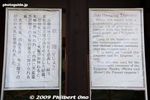
About the Zejo hanging tapestry.Jan 23, 2010
|
|

Jan 23, 2010
|
|

Zejo hanging tapestry inside the Kogosho.Jan 23, 2010
|
|

The Kogosho had a large Zejo hanging tapestry of a pine tree.Jan 23, 2010
|
|

Jan 23, 2010
|
|

Kogosho was a ceremonial hall for Coming-of-Age ceremonies for Imperial princes and when the emperor met with the shogun and daimyos. This building was reconstructed in 1958. 小御所Jan 23, 2010
|
|

Roof renovationsJan 23, 2010
|
|

Jan 23, 2010
|
|
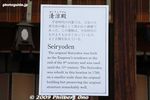
About the Seiryoden.Jan 23, 2010
|
|

Seiryoden 清涼殿Jan 23, 2010
|
|

The emperor's throne canopy inside the Seiryoden.Jan 23, 2010
|
|

We could clearly see inside the Seiryoden. 清涼殿Jan 23, 2010
|
|

Another major palace building is this Seiryoden, the emperor's residence from the late 8th century to 11th century. This is a reconstruction built in 1790 on a smaller scale, but close to the style of the original building. 清涼殿Jan 23, 2010
|
|
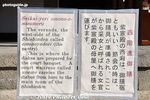
About the omonayadori.Jan 23, 2010
|
|

Even the uneme court waitress looks like a princess.Jan 23, 2010
|
|

Shishinden Hall, the most important building at Kyoto Imperial Palace. It faces a plaza of grooved, white gravel. 紫宸殿Jan 23, 2010
|
|

On this side of the Shishinden is the omonadori (pantry) with a depiction of the uneme court waitress who delivers food during the court banquet.Jan 23, 2010
|
|
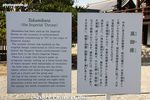
About the Takamikura Imperial Throne in English. Nice that they have English signs.Jan 23, 2010
|
|

It also houses the throne for the empress called the Michodai. Both the Takamikura and Michodai were originally made for Emperor Taisho's enthronement ceremony. 御 帳台Jan 23, 2010
|
|

We weren't allowed to enter the Shishinden, but we could see the Takamikura from outside. Notice the chair inside the canopy. This Takamikura and the Michodai for the empress were transported to Tokyo for Emperor Akihito's enthronement ceremony.Jan 23, 2010
|
|

Shishinden Hall is the most important building at Kyoto Imperial Palace. In houses the emperor's throne called Takamikura looking like an alcove. The enthronement ceremony for Emperor Taisho and Showa were held here.Jan 23, 2010
|
|
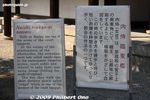
About the naishi toukan ni nozomu. Gee, how should we translate that into English? Jan 23, 2010
|
|

The naishi attendant court lady uses a folding fan to signal the respective court noble to take his seat at the court banquet. 内侍Jan 23, 2010
|
|

Jomeimon Gate looking from the inside.Jan 23, 2010
|
|

This is a depiction of the naishi toukan ni nozomu. Court lady attendant on the left and a court noble or Imperial prince on the right on standby.Jan 23, 2010
|
|

We finally get to see the Shishinden Hall, Kyoto Imperial Palace's focal point and main building. In the southeast corner was a mannequin display.Jan 23, 2010
|
|

Corner roof tile with Imperial crest.Jan 23, 2010
|
|

Imperial exhibits in Giyoden Hall.Jan 23, 2010
|
|

Bell (sho) and drum (ko) displayed in Giyoden.Jan 23, 2010
|
|

Mokou running curtain displayed in the Giyoden Hall. Hung in the Shishinden Hall during the emperor's enthronement. Jan 23, 2010
|
|

About Mokou running curtain.Jan 23, 2010
|
|

As we stood in line to enter Nikkamon Gate, we passed by the Giyoden Hall with various exhibits.Jan 23, 2010
|
|

Shunkoden Hall (春興殿) was built on the occasion of Emperor Taisho's enthronement in 1914. The wooden building's roof is made of copper plates.Jan 23, 2010
|
|

Nikkamon Gate (日華門)Jan 23, 2010
|
|

Nikkamon Gate (日華門) and Giyoden Hall (宜陽殿) on the right.Jan 23, 2010
|
|

Kenshumon Gate in the southeast corner of the palace. It has a karahafu-style roof. Originally used by Imperial messengers. 建春門Jan 23, 2010
|
|

Kenreimon Gate looking from the inside. Opened only for VIP visitors.Jan 23, 2010
|
|

Jan 23, 2010
|
|

Some flower arrangements along the wall corridor near Jomeimon Gate.Jan 23, 2010
|
|

View of Shishinden Hall through Jomeimon Gate.Jan 23, 2010
|
|

Jomeimon Gate is directly aligned with Kenreimon Gate. Of the three doors, the center door was used only by the emperor. Looks pretty new. 承明門Jan 23, 2010
|
|

Jan 23, 2010
|
|

Jan 23, 2010
|
|

Corridor near Jomeimon Gate.Jan 23, 2010
|
|

Round roof tiles with Imperial crest on the wall.Jan 23, 2010
|
|

Near the Shin-mikurumayose were souvenir shops.Jan 23, 2010
|
|

Jan 23, 2010
|
|
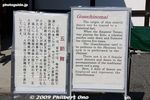
About the Gosechi-no-Mai court dancers.Jan 23, 2010
|
|

Jan 23, 2010
|
|

Gosechi-no-Mai court dancers (mannequins).Jan 23, 2010
|
|

Shin-Mikuruma-yoseJan 23, 2010
|
|
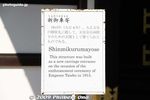
About the Shin-Mikuruma-yose in English.Jan 23, 2010
|
|

Roof of Shin-Mikuruma-yose.Jan 23, 2010
|
|

The Shin-Mikuruma-yose had a display of two mannequins posed as Gosechi-no-Mai dancers.Jan 23, 2010
|
|

Shin-Mikuruma-yose was designed for cars and was used only by the emperor. It was built in 1915 upon the enthronement of Emperor Taisho. 新御車寄Jan 23, 2010
|
|

Tora-no-Ma Tiger Room of the Shodaibu-no-Ma. Painted by Gantai (岸岱). 虎の間Jan 23, 2010
|
|

Tsuru-no-Ma Crane Room of the Shodaibu-no-Ma. Painted by Kano Eikaku. 鶴の間Jan 23, 2010
|
|

Veranda of Shodaibu-no-Ma. Jan 23, 2010
|
|
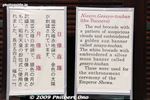
About the Nissho and Gessho banners.Jan 23, 2010
|
|

Tsuru-no-Ma Crane Room of the Shodaibu-no-Ma. Painted by Kano Eikaku. 鶴の間Jan 23, 2010
|
|

Room inside Shodaibu-no-Ma with Nissho and Gessho banners.Jan 23, 2010
|
|

Shodaibu-no-Ma is a waiting room for dignitaries making official visits to the Palace. It has three anterooms and the VIP would be ushered into one of the three rooms in accordance with rank. 諸大夫の間Jan 23, 2010
|
|

Inside the Okurumayose entrance.Jan 23, 2010
|
|

Roof of Okurumayose.Jan 23, 2010
|
|

First thing we saw after entering was this Okurama-yose entrance for VIPs arriving by ox-drawn carriage. Connected to the Shobudai-no-Ma room. 御車寄Jan 23, 2010
|
|

3D map of Kyoto Imperial Palace and the route we were allowed to take. For this special occasion of Emperor Akihito's 20th anniversary, we were also allowed to tour the northern palace quarters which is normally closed to the public.Jan 23, 2010
|
|

Gishumon Gate, the entrance to Kyoto Imperial Palace when it is open to the public in spring and fall. During Nov. 1-10, 2009, anyone could freely enter. Normally, you have to apply (send in a form) to be able to take a tour of the palace. 宜秋門Jan 23, 2010
|
|

Roof of Gishumon Gate. If you like Japanese architecture, art (painting), Japanese history, or the Imperial family, visiting the Kyoto Imperial Palace is a must. Much more traditional than the current Imperial Palace in Tokyo which actually was a castle.Jan 23, 2010
|
|

The Kyoto Imperial Palace is spread over 27 acres or about 110,000 square meters. It's rectangular as is the national garden that surrounds it.Jan 23, 2010
|
|

Way to Gishumon Gate where we could enter the Kyoto Imperial Palace. In the old days, this gate was used by government ministers, siblings of the emperor, court nobles, and princes and princesses.Jan 23, 2010
|
|

The Kyoto Imperial Palace is actually within a much larger compound called the Kyoto Gyoen National Garden. The palace itself is walled within this spacious garden. This earthen wall is called tsujibei.Jan 23, 2010
|
|

Roof tiles of palace wall. Kyoto Gyoen National Garden is rectangular. It used to be a town of 200 homes of court nobles surrounding the Imperial Palace while the emperor lived in Kyoto. Jan 23, 2010
|
|

After Emperor Meiji moved to Tokyo in 1869, the town of court nobles around the old Kyoto Imperial Palace deteriorated. When Emperor Meiji saw this sorry state when visiting Kyoto in 1877, he ordered ordered this area to be reconstructed.Jan 23, 2010
|
|

I visited the Kyoto Imperial Palace in Nov. 2009 when it was open to the public to mark the 20th anniversary of Emperor Akihito's enthronement. This is Kenreimon Gate, used only by the emperor and heads of state. 建礼門Jan 23, 2010
|
|

Almost all the current buildings in Kyoto Gosho were recomstructed in 1855. But they include Heian Period-style architecture.Jan 23, 2010
|
|

This broad, graveled path makes it very stately and the gate up ahead is the main gate. However, it is reserved only for VIPs, and common folk like us must use a side gate to enter the palace when it is open to the public.Jan 23, 2010
|
|

The Kyoto Imperial Palace (Kyoto Gosho) was the emperor's residence from the 14th century to 19th century. This is the main path to the palace where major festivals such as the Aoi Matsuri and Jidai Matsuri are held.Jan 23, 2010
|
|

From the Kyoto Imperial Palace, the procession proceeds on main roads to Heian Shrine.Nov 07, 2009
|
|

These men are descendants of the original archers who protected Emperor Kammu. 弓箭組列Nov 07, 2009
|
|

The Tamba area of Kyoto (now Kameoka) had skilled archers. These archers were employed to protect Emperor Kammu's entourage while the Heian capital was being moved.Nov 07, 2009
|
|

Nov 07, 2009
|
|

The Procession of Archers is the last group of this festival.Nov 07, 2009
|
|

Nov 07, 2009
|
|

Shirakawa-me were women from Shirakawa River (below Mt. Hiei) who grew and sold flowers. They began bringing flowers to the Imperial Court as gifts during the Heian Period. 白川女献花列Nov 07, 2009
|
|

Shirakawa-me woman. 白川女献花列Nov 07, 2009
|
|

Procession of Shirakawa-me. 白川女献花列Nov 07, 2009
|
|

Nov 07, 2009
|
|

Director's carriage 総長Nov 07, 2009
|
|

Procession magistrates 列奉行Nov 07, 2009
|
|

Shrine priestNov 07, 2009
|
|

Nov 07, 2009
|
|

The second palanquin (horen) bears the spirit of Emperor Kammu. 桓武天皇 御鳳輦Nov 07, 2009
|
|

Nov 07, 2009
|
|

Nov 07, 2009
|
|

The first palanquin bears the spirit of Emperor Komei. 御鳳輦Nov 07, 2009
|
|

Nov 07, 2009
|
|

Palanquin (horen) bearing the spirit of Emperor Komei. 孝明天皇 御鳳輦Nov 07, 2009
|
|

Nov 07, 2009
|
|

Shinko-retsu Procession is the heart (and spirits) of the Kyoto Jidai Matsuri. It features two palanquins bearing the spirit of two emperors. 神幸列Nov 07, 2009
|
|

Nov 07, 2009
|
|

Nov 07, 2009
|
|

Nov 07, 2009
|
|

Karyobinga 迦陵頻伽Nov 07, 2009
|
|

Karyobinga depicts a beautiful bird which lives in the Pure Land (Heaven). 迦陵頻伽Nov 07, 2009
|
|

In green is the Kocho dancer with butterfly wings. In orange is the Karyobinga.Nov 07, 2009
|
|

This procession provides music and dance prior to the palanquins.Nov 07, 2009
|
|

Nov 07, 2009
|
|

These are members of the Kyoto Restaurant Association who are entrusted with making offerings for Heian Shrine.Nov 07, 2009
|
|

Nov 07, 2009
|
|

Procession Preceding the Palanquins (Zen-retsu) 前列Nov 07, 2009
|
|

Nov 07, 2009
|
|

Nov 07, 2009
|
|

Nov 07, 2009
|
|

Procession of Offerings to the Gods 神饌講社列Nov 07, 2009
|
|

The costumes of this period has a strong Chinese influence.Nov 07, 2009
|
|

The color of the noble's wardrobe indicated his rank.Nov 07, 2009
|
|

Nov 07, 2009
|
|

Procession of Enryaku Period Court Nobles 延暦文官参朝列Nov 07, 2009
|
|

将佐Nov 07, 2009
|
|

将佐Nov 07, 2009
|
|

Nov 07, 2009
|
|

副将Nov 07, 2009
|
|

Sakamoto Tamuramaro 坂上田村麻呂Nov 07, 2009
|
|

Nov 07, 2009
|
|

Nov 07, 2009
|
|

将佐Nov 07, 2009
|
|

Procession of Enryaku Period Court Warriors 延暦武官行進列Nov 07, 2009
|
|

Wake-no-Hiromushi 和気広虫Nov 07, 2009
|
|

Enryaku Period (782-806) 延暦時代:延暦武官行進列Nov 07, 2009
|
|

Wake-no-Hiromushi's orphan kidsNov 07, 2009
|
|

Kudara O Myoshin was the wife of a prominent government official. Chief Lady in Waiting for Emperor Kammu. 百済王明信Nov 07, 2009
|
|

Kino Tsurayuki-no-Musume was the daughter of famous poet Tsurayuki. 紀貫之の女Nov 07, 2009
|
|

Ono no Komachi was a famous poet reputed to be exceptionally beautiful. She wrote many poems about love as she had many love affairs. 小野小町Nov 07, 2009
|
|

Wake-no-Hiromushi was a caretaker of many orphan children. She was a catalyst for Japan's orphanages. 和気広虫Nov 07, 2009
|
|

Ono no Komachi's maid. 侍女Nov 07, 2009
|
|

Lady Murasaki Shikibu (left) was the author of Tale of Genji (Genji Monogatari). Sei-Shonagon (right) authored "The Pillow Book" and wears a juni-hitoe 12-layer kimono. 清少納言、紫式部Nov 07, 2009
|
|

Tokiwa-gozen's sonNov 07, 2009
|
|

Tokiwa-gozen was a concubine of Minamoto no Yoshitomo. She is shown with her children. 常磐御前Nov 07, 2009
|
|

Pulled on a cart are Sei-Shonagon and Lady Murasaki Shikibu. 清少納言、紫式部Nov 07, 2009
|
|

Yokobue was a court servant who fell in love with Takiguchi-no-Tokiyori, a warrior. His family rejected her and he sought solace by becoming a priest. She is on her way to visit him in the Saga area of Kyoto. 横笛Nov 07, 2009
|
|
| 2715 files on 11 page(s) |
 |
 |
8 |  |
 |
|